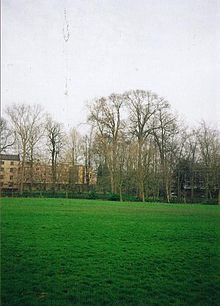- Ulmus × hollandica 'Vegeta' (Chichester Elm)
-
Ulmus × hollandica
Chichester Elms, Queen's College, CambridgeDetails Hybrid parentage U. glabra × U. minor Cultivar 'Vegeta' Origin England The Chichester Elm is the original Ulmus × hollandica 'Vegeta', but suffered confusion with the later Huntingdon Elm hybrid by Loudon, which he also accorded the epithet 'Vegeta' as he found the two cultivars indistinguishable from each other [1] [2]. The cultivar was cloned at the beginning of the 18th century from a tree growing at Chichester Hall, Rawreth, near Danbury, in Essex, England, then the home of Thomas Holt White FRS, brother of the naturalist Gilbert White.
Contents
Description
A very tall tree, with foliage similar to that of the Huntingdon Elm. The Rev. Adam Buddle originally identified the tree as 'a smooth leaf Wych Elm'
Pests and diseases
The tree is susceptible to Dutch elm disease.
Cultivation
Examples of the tree were presented in 1711 by Adam Buddle to the Chelsea Physic Garden; Buddle held a living at North Fambridge, not far from Rawreth [3]. Adam Holt, relative of Thomas Holt, distributed the elms nationwide in the 1720s [4]. Chichester Elms were known to have been marketed in 1801 by nurseryman George Lindley, father of the eminent botanist Professor John Lindley FRS [3], at Norwich. The origin of the connexion with Norwich is not known, nor is the origin of the claimed source of the tree in later 19th century catalogues as 'North America'. The tree is known to have been marketed in Australia in the early 20th century by the former Gembrook Nursery, but no examples are known to survive. There is no record of the tree's introduction to North America.
Notable trees
File:Chapelfield Elm Norwich.jpgChapelfield Elm. Photo: Liz Goodyear.Notable examples survive, either courtesy of their isolation from diseased stock, as at Queens' College, Cambridge, where two are 44 m in height (2009), or annual inoculation with fungicide, as at Chapelfield Gardens, Norwich. Chichester Elms were planted at Woburn Abbey in the 1730s by Thomas Holt, who was agent for the estate, and are recorded in photographs in Arboretum Woburnense (1915); they no longer survive. NB: The Queens' College elms are to be propagated in 2009 from cuttings by the National Trust as part of its Plant Conservation Programme.[citation needed]
Etymology
The tree was almost certainly named for Chichester Hall, whence it originated. The epithet 'Vegeta' was bestowed by John Lindley in 1823 in Hortus Cantabrigiensis, whose title authorship lists the long - dead Donn.
Synonymy
- U. campestris var. Cicestria: W. A. & J. Mackie, Norwich, Catalogue, 1812, p.59.
- U. cestria : George Lindley , Norwich, catalogue, 1801.
- U. cicestriensis : George Lindley, Norwich, catalogue, 1815.
Accessions
Europe
- Brighton & Hove City Council, UK, NCCPG Elm Collection [2].
- Cambridge Botanic Garden [3], University of Cambridge, UK. No accession details available.
- Royal Botanic Garden Edinburgh. Acc. no. 19699364
References
- ^ Richens, R. H. (1984). Elm. Cambridge University Press.
- ^ Green, P. S. (1964). Registration of cultivar names in Ulmus. Arnoldia, Vol. 24. Arnold Arboretum, Harvard University. [1]
- ^ a b Smith, R.I. (2006). Looking for the Chichester Elm. The Professional Gardener No. 112, July , 2006.
- ^ Hadfield, M. (1969). A history of British gardening. Spring Books, London. ISBN: 0600017885
Categories:- Elm cultivars
Wikimedia Foundation. 2010.


